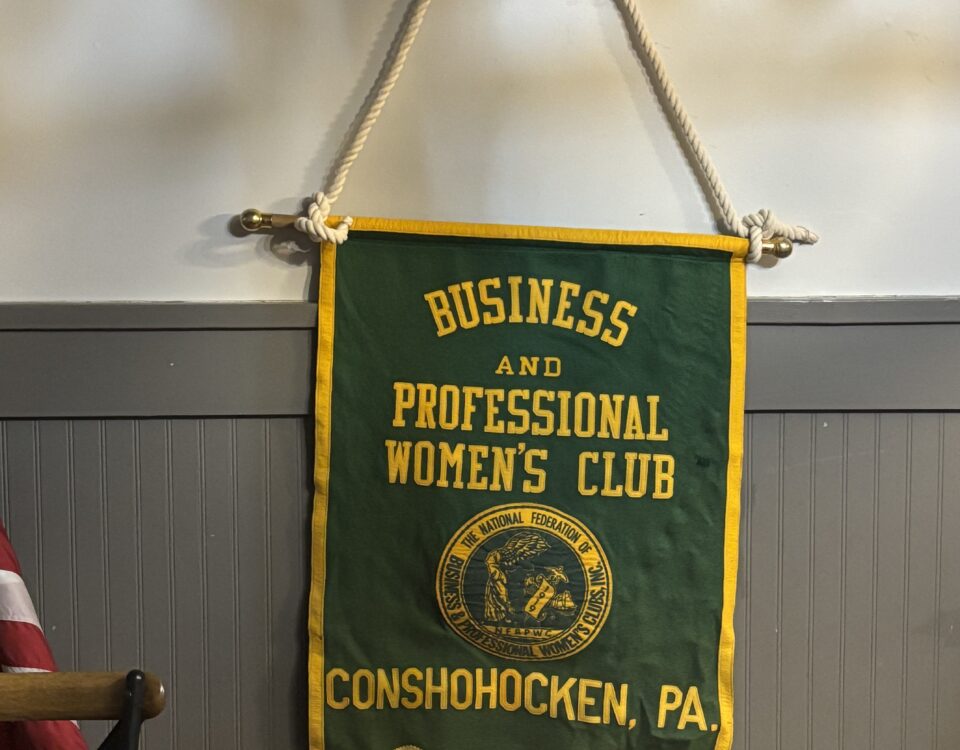The Long Goodbye… Hey Gerry, We Owe Ya One
February 17, 2014
Talkin’ Music with Jack – Only The Good Die Young
February 19, 2014Conshohocken Black History

Conshohocken Black History
Something To Be Proud Of
For Both Black and White
By Jack Coll
This was originally posted to Conshystuff in 2014
February is “Black History Month,” America takes the opportunity to honor many of the African America leaders from over the years. We also look at the many things and events that helped shape this nation particularly moments during the course of the Civil Rights Movement, local and national Black leaders, and the progress we’ve all made today in bringing this country together.
If you’re looking for local black history, well Conshohocken is full of it. While the Civil Rights Movement was raging on and capturing national headlines, smaller communities across America were also on the front lines fighting and winning desegregation one day at a time.
Conshohocken has been home to more than a few community Black Leaders throughout our history.
Edward “Ned” Hector, Revolutionary War Hero; Reverend J. J. Campbell, First Pastor at St. John’s African Methodist Episcopal Church, (AME) Rev. Abram Lee, father of Marshall Lee, Abram founded a church in Roxborough and helped his son Marshall with the formation of St. Paul’s Church. Rev. Marshall Lee, Founder and Pastor at St. Paul’s Church, Rev. Marshall Lee took the lead in so many activities that helped shape this great borough we live in. (Read more about Marshall Lee in “Tales Of Conshohocken & Beyond”) Reverend James Groves, whom I considered a friend, Groves had about 10,000 friends who live or have lived in this borough. Olive Lee Banks, who broke the color barriers throughout Montgomery County. Other prominent Black leaders in the community are plenty including Darlene Groves, Frank and Gus Morgan, George Bland, Lucius Carter and many others.
St. John’s AME Church located on the north-east corner of Eighth Avenue and Harry Street dates back to the 1870’s, parishioners were worshiping at St. John’s church about 45 years before St. Paul’s Church was constructed.
In 1879 former President Abraham Lincoln’s signature was barely dry from the signing of the Emancipation Proclamation he had signed about 15 years earlier. Former slaves were making their way through the country looking for the American Dream. In 1877 when the African American residents of Conshohocken were meeting at Stemple’s Hall and looking for a place to worship a Black Exodus was taking place in which tens of thousands of African Americans migrated from the southern states to Kansas and beyond.
By 1881 African Americans were spreading their wings, Speiman College was opened and served as the first college for black woman in the United States. The school was founded by Sophia Packard and Harriet Giles. In 1881, Booker T. Washington founded the Tuskegee Normal and Industrial Institute in Alabama, the school became one of the leading schools for higher learning for African Americans, George Washing Carver would become an instructor at the school.
It was also in 1881 that black members of the Methodist faith in Conshohocken started building their church. The property at Eighth Avenue and Harry Street was purchased in 1880 by members of the church from Mr. and Mrs. John Auger for the sum of $200.00. To give you an idea of the cost of the property, laborers back in 1880 were lucky to be making fifteen cents a day, for ten hours of work.
Within a year in 1881, a building was erected under the watchful eye of Reverend J. J. Campbell, he was the driving force behind the formation of Conshohocken’s church.
The Conshohocken AME Church when constructed was heated with a wood burning stove and lighting was provided by large lanterns placed throughout the church. Although the church was built and worship services were being held on Sundays, along with activities throughout the week, many renovations and improvements have continued throughout the years.
In 1928, under the guidance of Pastor J. H. Caulk, the church secured a loan for $800.00 for improvements. A stone wall was constructed on the Eighth Avenue side of the Church, steps on the front of the building and a cement walk around the building. In 1943 Rev. Sterling Pinkett worked to put an addition on the front of the Church.
In 1979 Rev. William L. Johnson, a native of Conshohocken a member of St. John’s Church since birth became Pastor. It was Rev. Johnson who celebrated St. John’s centennial on September 25, 1981.
Under the direction of Rev. Cora L. Palmer the Guyton Memorial Hall was dedicated on September 16, 1995. Pastor Elton Guyton served St. John’s on two different occasions, from 1940-43 and from 1949-1963. Rev. Guyton posted many accomplishments throughout his 18 years of service to the church and was honored with St. John’s Memorial Hall named in his honor.
Rev. Edith J. Patterson Payne has been serving St. John’s Conshohocken AME Church for nearly two decades. Reverend Patterson has no intentions of taking her foot off the gas, she has initiated a number of programs over the years and recently completed a total interior make-over of the church in an effort to better serve the congregation and members of the community.
St. John’s Church has thrived in Conshohocken for more than 130 years driven by the pride of the Pastors who have served the church and our African American citizens who live in and around Conshohocken.
St. Paul’s Baptist Church was founded 90 years ago in the early 1920’s when the Alan Wood Steel Company recruited many laborers from the south to come live and work in Conshohocken. While St. John’s African American Church was thriving it was a Methodist Church, many of the African American families recruited from the south were worshiping Baptist and would travel for miles on Sunday to practice their faith. In an effort to stay closer to home a temporary church was set up in 1924 in the old James Hall Mill then located in West Conshohocken. On April 29, 1925 the church was organized by the late founders Rev. Marshall Lee, Walter Woods, Stephen Soloman, Demmie Hill Milton, and Mattie Hill Smith.
Rev. Marshall Lee was called to the pastorate, April 29, 1925, and a year later in 1926 St. Paul’s was incorporated under the laws of the state of Pennsylvania. St. Paul’s acquired property at the corner of Third Avenue and what was known as Cinder Hill, (Hallowell Street) and ground breaking ceremonies were held in September 1926.
In 1925 the Alan Wood Steel Company was producing more than eight percent of the nation’s output in steel, the company employed more than 5,000 local residents. Because of the company’s large labor demand African Americans living in the south who were looking for a better way of life were recruited by the Alan Wood Steel company to relocate to the Conshohocken area where they could live and work assured of a good working wage. An influx of African American citizens in Conshohocken followed.
(For more history on the African Americans in Conshohocken stay tuned for Jack and Brian Coll’s new book “Conshohocken in pictures and Short Stories,” due out in late 2014, or early 2015)
With the influx of African American Baptist, St. Paul’s Church was able to add an edifice in 1927 thanks to Alan Wood Steel Company donating the stone needed for the addition. Several additions were made to the church during the 1950’s and 1960’s. These years were exciting times in our borough especially for our African American citizens. Both of the black churches were thriving, many of the African American students going to our schools were involved in sports at the local high schools, other kids were involved in programs at the Fellowship House and or parks. Many more jobs outside the steel mills were opening up and the borough had many firsts by leading African American residents.
James Groves, a very well respected Pastor at St. Paul’s Church carried the church’s community involvement to a higher level. Rev. Groves who followed in the footsteps of Rev. Lee was a home grown leader having attended school at Conshohocken High, and was part of the 1950 undefeated football team. Rev. Groves didn’t just participate on a number of Board of Directors in the borough, but was a contributing member offering positive guidance for many of the organizations he was involved with, not to mention the positive direction the church was going in.
It saddens me to think that most of the people living at Marshall Lee Towers aren’t even aware who Marshall Lee was and what he meant to this community, and what he meant to the residents of Montgomery County. It also saddens me to think of all the younger residents rushing in to Conshohocken and buying homes along Hector Street, not knowing who Edward “Ned” Hector was, and the pride he brought to this borough. The only State Historical Marker posted within the borough limits is a historical marker located on the corner of Hector and Fayette Streets honoring and recognizing Edward “Ned” Hector, an African American Revolutionary War hero, who lived just a couple hundred yards from the location of the marker. And it saddens me to think that no permanent honors have been bestowed upon Rev. James Groves, perhaps an area in the borough honoring his name.
Conshohocken African American leaders have been plenty over the years, teaching our children at Conshohocken Elementary School about such leaders, along with the rest of our local history is an opportunity missed. We teach our children about great men from another time from far, far away, but won’t take the time to teach them about our own history. Names like Reuben Hoffecker, Robert Landis, John Elwood Lee, and James and Alan Wood. I wonder if children and adults alike even know that Lewis Lukens’s donated his house to serve as our library. I wonder if our students at Conshohocken Elementary realize that the make-up of our great community is based on the arrival of the Irish, Italians, Polish, African Americans, Germans, Jewish, and now members of the Mexican countries.
Perhaps if we take the time to brag about our own success stories more of our students would strive to be like John Elwood Lee, Marshall Lee, James Groves, Del’ Rel Scott, and Ned Hector.
If you’re looking for Black History, a fifteen minute lesson on Martin Luther King doesn’t quite meet our standards in Conshohocken, a semester or two, or three might put us all on the road to understanding our own local history, and that would lead to our youngsters spreading their wings in search of a better life and better understanding.
Editors Notes
Jack and Brian Coll are currently working on a book titled “Conshohocken in Pictures and Short Stories.” We are looking for your help, we would like to incorporate a chapter on Conshohocken Black History. We really know very little about our boroughs African American community, and would like to hear from you. When did your family first come to Conshohocken, did your parents work in the steel mills or elsewhere? Do you have any family photos in front of your house, at the playground or at a family picnic? Did you or your parents, or one of your relatives have a business in Conshohocken, a corner store, a contracting business or other business? We would like to hear from you.
You can contact us at 610-825-7072, or by stopping by our store at 324 Fayette Street, or by e-mail JCOLLFRAME@AOL.COM
Jack Coll has been writing on the history of Conshohocken for more than a quarter of a century and has spent many years photographing the borough’s history and changes. Jack and Brian have written several books on Conshohocken including:
Conshohocken Then & Now
Conshohocken and West Conshohocken in Sports
Remembering Conshohocken and West Conshohocken
Tales of Conshohocken & Beyond
Conshohocken and West Conshohocken in Pictures 2012
Among others

